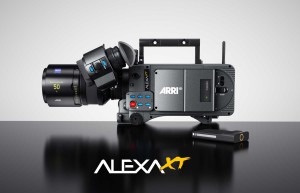 ARRI announced that it is refreshing its Alexa product line with the introduction of four new Alexa XT (Xtended Technology) cameras, incorporating features inspired by feedback from professional users. The Alexa XT, Alexa XT M, Alexa XT Plus and Alexa XT Studio cameras will replace all previous models except for the original Alexa.
ARRI announced that it is refreshing its Alexa product line with the introduction of four new Alexa XT (Xtended Technology) cameras, incorporating features inspired by feedback from professional users. The Alexa XT, Alexa XT M, Alexa XT Plus and Alexa XT Studio cameras will replace all previous models except for the original Alexa.
ARRI is also offering an upgrade that equips all existing Alexa cameras with one of the major features of the XT configuration – the new XR Module (Xtended Recording), which allows ARRIRAW data to be recorded in-camera to a new internal digital magazine, co-developed with Codex to replace the previous SxS Module.
“During the transition from film to digital movie-making, ARRI and Codex have formed a strong collaborative partnership and have been fortunate enough to have been the choice for so many feature films over the last couple of years,” said Marc Dando, managing director of Codex. “We decided to tie the camera and recorder more closely together, based on input from our many customers around the world.”
All new Alexa XT models will ship with the XR Module. The result is a smaller, lighter cable-free camera package that records ARRIRAW, Alexa’s highest quality image output, inside the camera. Alexas can now capture ARRIRAW up to 120 fps onto rugged 512 GB XR Capture Drives.
The XR Capture Drive supports a few different postproduction workflows. In addition to ARRIRAW, ProRes or DNxHD can also be captured to the XR Capture Drive for significantly longer recording times, as well as ProRes 4444 recording at 120 fps. With an SxS Adapter it is also possible to record ProRes or DNxHD to a single SxS PRO card.
The In-camera Filter Module IFM-1 allows Alexa XT models to be rated at the base sensitivity of EI 800 without the need for external Neutral Density (ND) filters, even in bright sunlight. Filtering behind the lens rather than in front saves time and reduces weight, reflections and operational complexity. The precision IRND filters used in the IFM-1 are based on innovative technologies that assure highest image quality and perfect color balance at all of the eight available densities, from ND 0.3 to ND 2.4.
For the most effective use of anamorphic lenses, each Alexa XT model is equipped with a 4:3 sensor, the same size and shape as a Super 35 mm film frame. This is crucial for delivering the unique and cinematic widescreen look that can trace its origins back to the CinemaScope films of the 1950s.
An anamorphic de-squeeze license is included with all XT cameras, as is a high-speed license for filming at up to 120 fps. The 4:3 sensor will also be useful on non-anamorphic productions as it permits significant reframing of the image in post, similar to shooting 4-perforation 35 mm.
Alexa XT models will be equipped with an LDS lens mount to capture lens metadata. The ARRI Lens Data System (LDS) reads the position of all lens rings and writes them into metadata in every format Alexa can record. More than 41 lens models have LDS built in, including the ARRI/ZEISS Master Anamorphic, Master Prime and LDS Ultra Prime series, the Master Macro 100 and the ARRI/FUJINON Alura Lightweight Zooms. For other lenses it is possible to store the lens table inside the Alexa by using the Lens Data Archive feature.
The company is also introducing a new viewfinder mounting bracket with a much stronger and more rigid design, and a quieter fan that will provide an extra safety margin in very quiet or very hot environments.





